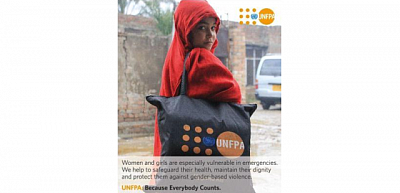By Dr. Babatunde Osotimehin, UNFPA Executive Director World Population Day 2015 reminds us that women and girls are particularly vulnerable in humanitarian emergencies – but also play an active role in helping their communities cope with the effects of disaster. This should be reflected in strong recommendations at the upcoming World Humanitarian Summit Regional Consultation in Dushanbe later this month.
By Dr. Babatunde Osotimehin, Executive Director of UNFPA, the United Nations Population Fund
Ishwari Dangol spent 12 hours trying to pull her seven-year-old son from the rubble of the massive earthquake that shook Nepal in April. She was seven months pregnant at the time, and has since struggled to access antenatal care and cope with her son’s tragic death.
Ishwari’s experience shows just how vulnerable women are when natural disasters strike. Yet their specific needs are often ignored in crises.
We don’t know when the next disaster will occur, or where. But we do know that the frequency and impact of natural catastrophes are on the rise globally, with the Asia and Pacific region highly prone to earthquakes, floods, landslides and drought. This is why it is crucial for governments across this vast region to urgently get their preparedness systems up to speed, so that they are ready when disaster strikes. We have seen far too often how disaster risk reduction strategies have failed and how ill-prepared countries have slipped into a state of full-on emergency where lives are at even greater risk and the most basic needs are not met.
World Population Day, marked on 11 July with a focus this year on vulnerable populations in emergencies, is a timely opportunity to highlight the role, needs and rights of women and adolescent girls in emergency preparedness and disaster response.
As Ishwari’s story reminds us, natural disasters magnify the vulnerabilities and needs of women and girls. Pregnant women, in particular, fear for their health and that of their unborn babies and wonder if they will deliver safely, as health centers and other key infrastructure may be destroyed, overcrowded, or inaccessible. Skilled birth attendants and emergency obstetrics care often become scarce or unavailable. In fact, an estimated 60 percent of all maternal deaths occur in emergency settings.
During crisis situations, women and girls are at much greater risk of reproductive health problems, sexual abuse and other forms of gender-based violence, forced marriage and even death. Worldwide, women and children are estimated to be up to 14 times more likely than men to die in a disaster.
For women and girls, part of being safe during humanitarian crises — whether natural disasters or man-made conflicts — means ensuring safe birth, safety from unintended pregnancy, and protection from violence.
Placing the protection and health of women and girls at the center of humanitarian response also makes communities more resilient and helps with recovery. Time and again, women, including young women, rise to the challenge of sustaining their households during difficult times and are often at the forefront of responding to disasters in their communities.
Ensuring their health and safety therefore is not only a moral obligation; it is also a strategic investment in disaster risk reduction that improves the rights of individuals and strengthens the resilience of nations.
For these reasons, the international community agreed at the United Nations General Assembly last year that basic health measures during humanitarian emergencies should include sexual and reproductive health services to save the lives of women, girls and newborns. This was reiterated and reinforced earlier this year in the Sendai Framework for Disaster Risk Reduction, which charts the way forward for the next 15 years.
Now, as governments, civil society representatives and other humanitarian actors from Central and South Asia gather in Tajikistan’s capital Dushanbe on 28-30 July for the last regional consultation ahead of the 2016 World Humanitarian Summit in Istanbul, we must ensure that the needs of women and girls are placed front and center in emergency preparedness plans and humanitarian response in the region and beyond.
National governments and local authorities can do a lot in this regard.
Engaging women and young people as partners in preparedness planning is crucial. This must include all populations that could be at particular risk, including ethnic minorities.
Being prepared also means knowing where populations are and what their vulnerabilities are. The collection and analysis of population data, disaggregated by sex and age, must be strengthened so that humanitarian interventions reach all people in need, especially the most vulnerable and under-served.
Setting up appropriate coordination mechanisms to guarantee the delivery of a minimum initial service package for reproductive health is another important aspect of preparedness. This package should help prevent gender-based violence, assist survivors of sexual assault by providing psychosocial counselling and health interventions to reduce the risk of HIV and other sexually transmitted infections, and safeguard the health of pregnant women, new mothers and their infants.
At UNFPA, the United Nations Population Fund, we are expanding our capacity to provide these services in partnership with governments and civil society – making sure that the rights and needs of the most vulnerable populations are at the forefront of humanitarian response to maintain their dignity, protect them from violence, and provide access to sexual and reproductive health services as quickly as possible when emergencies strike.
That is how we will ensure the health and safety of women and girls, and ultimately, the well-being and resilience of families, communities, countries and our world.
FACTSHEET: World Humanitarian Summit - Placing Women and Girls at the Centre read
- (final_whs_s_c_asia.pdf, 204.3 kB)


